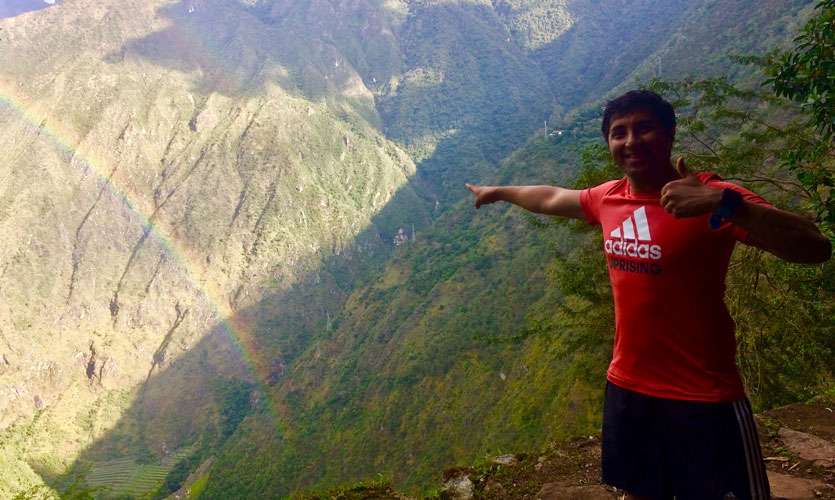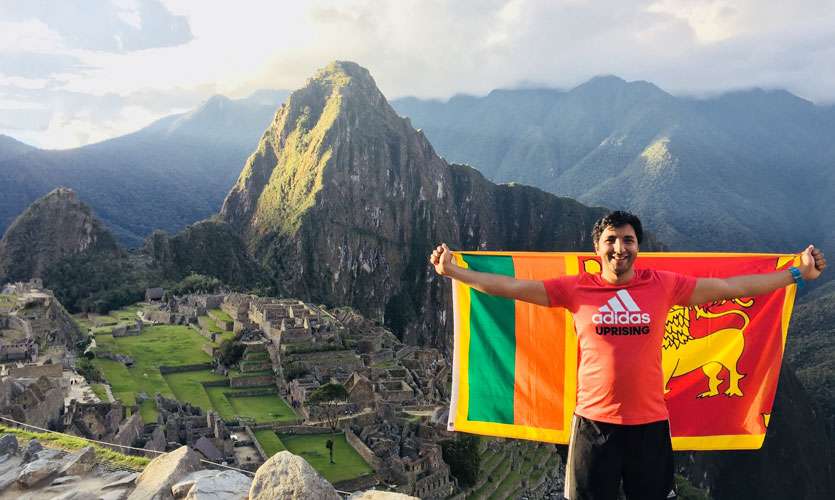Aug 31 2018.
views 1061
Hassan Esufally has been achieving his dreams of becoming the first Sri Lankan to run a marathon on all seven continents, one step at a time. The Daily Mirror Life caught up with Esufally, fresh off having completed the Inca Trail Marathon - and becoming the first Sri Lankan to do so.

Touted as “the most difficult marathon in the world”, the Inca Trail Marathon was, unsurprisingly, fraught with innumerable trials for Esufally; part of the allure for a Marathon renowned for being extremely challenging. Esufally explained that the marathoners hiked 13km to Llactapata the day before the marathon. They camped here for a night with a 2am wake up call to prepare for a 4am start time. “I had a bit of bad luck as my hydration pack was leaking and I then found out it had a hole. This was disappointing but I didn’t let this bring me down too long. I changed my strategy to carrying my fluids on a running belt and via a hand held bottle on a glove (Cheers to Linda my fellow runner who gave me her bottle, a beanie, and a waterproof jacket). Tough situations create tough people”.
It didn't take long for Esufally to have to step out of his comfort zone. “We started the race in total darkness with only our headlamp to lead the way. This was challenging for me given that I’ve never actually run with a headlamp before. But I knew that this was only the start of having to push myself outside my comfort zone during this race to achieve my end goal!”.

Proving that the challenges ahead only increased in intensity, the marathon comprised a range of weather conditions. “We had snowy, rainy, sunny and windy conditions at different points on top of dealing with the brutality and ruggedness of the terrain!”, Esufally explained. “At the start of the race it was cold and dark, then as the sun rose it became became hot and wet we made our way to the hardest uphill section - Dead Woman’s Pass. We knew we had arrived through the lush rainforests of the Amazon basin. This point is the continental divide between the Inca Empire and the Amazon and a sign that the hardest section of the marathon is coming - climbing upto 13800 ft! The weather conditions changed again to snow and ice and it was freezing cold at the top! I had to change my gear to suit the weather conditions and furthermore, the altitude was a real killer; the thin air made it difficult to breathe, but having acclimated for a few days and my training with my high altitude mask paid off in this regard”..

Running the world's most difficult marathon solo was not ideal. Esufally, however, ran the first have of the race alongside fellow runner Melissa. “We took amazing pictures of captivating views and really enjoyed this part of the course. I am a better downhill runner than an uphill runner so I walked the uphills and ran fast down the downhills. This was a great partnership as we exchanged food and shared stories to keep each other going!”. While a good running companion proved to be a great, the Esufally soon faced more challenges. “By the half marathon point I had twisted my ankle 5 times on each leg; my legs and body were so sore but despite that I decided I would break away from Melissa in order to make the time cut off for the Winay Wayna gate. At the third pass of Runkurakay there was a point going uphill where an English family actually let me borrow their walking sticks to get up to 12,000 ft. This was really nice of them and in general hikers were very respectful of the marathon runners and gave us preference on the course. Around an hour before the gate cut off, my watch died and I had to run on instinct after this. I got to the final aid station at Puyupatamarca and left all my layers there in order to be as light as possible for what was to be the most grueling section yet! The race director had told me that those who usually make the gate cut off get to the final aid station with 1.5 hours left to go - I had just 1!”.
Propelled by a surge of adrenaline, Esufally asds that he “ran like a maniac and prayed to god, thought of my grandfather, my high priest and it was like something inside me struck me like a bullet and I had this newfound energy! Despite all the hardships, despite running on instinct with no calculation of my pace, and despite twisting my ankles again due to running downhill on treacherous trail I knew I would make the gate cut off and I did. Got the the gate with two minutes to spare!”.

Good things - especially beautiful views - don’t come easy. But when you chance upon such glorious views, it all becomes worth it. “After the Winay Wayna gate it was onto the famous Sun Gate where you get your first glimpse of the breathtaking Machu Picchu and see the end in sight. This was I think one of the most amazing parts of the race! Getting to there knowing that I would get to experience Machu Picchu through the Sun Gate was both rewarding and relieving! At this point I knew the hardest part of the race was over and I could enjoy last few miles and really take in that hike of glory to Machu Picchu. I saw a beautiful rainbow on the way, climbed uphill for a about 30 minutes and then through the forest I saw a beam of light which was this amazing door of sunlight! I knew I was at the Sun Gate and to see the ancient lost city of Machu Picchu for the first time from up there was truly rewarding given the hard work I had put in to get here. I really soaked it all in, took pictures and radioed my wife Rashida to say I was on the way to the finish line! I had tears in my eyes when I found out that she had been waiting for me at Machu Picchu for over 4 hours! I couldn’t wait to run down the last mile and a half to get to see her”.

“I ran across the ‘finish line’ (which was our tour guide Fredy, as out of respect to the Inca Trail you are not allowed any paraphernalia on the site) with the Sri Lankan flag hoisted above my shoulders to the finish line with Machu Picchu in sight! It was unlike any other feeling I have experienced before; finishing the world’s hardest marathon at this magnificent Incan citadel!
This race was more than just a race - it was a life changing experience. To have been given in depth information about the different sights on the trail and having seen the different Inca ruins and understood their significance was amazing! To have finished an extremely difficult trail (+12km extra to make it a marathon) in 12.5 hours- a trail that usually takes people 3 nights and 4 days, certainly gives one confidence of going after their dreams - which is exactly what I’m so grateful to be doing”.
0 Comments